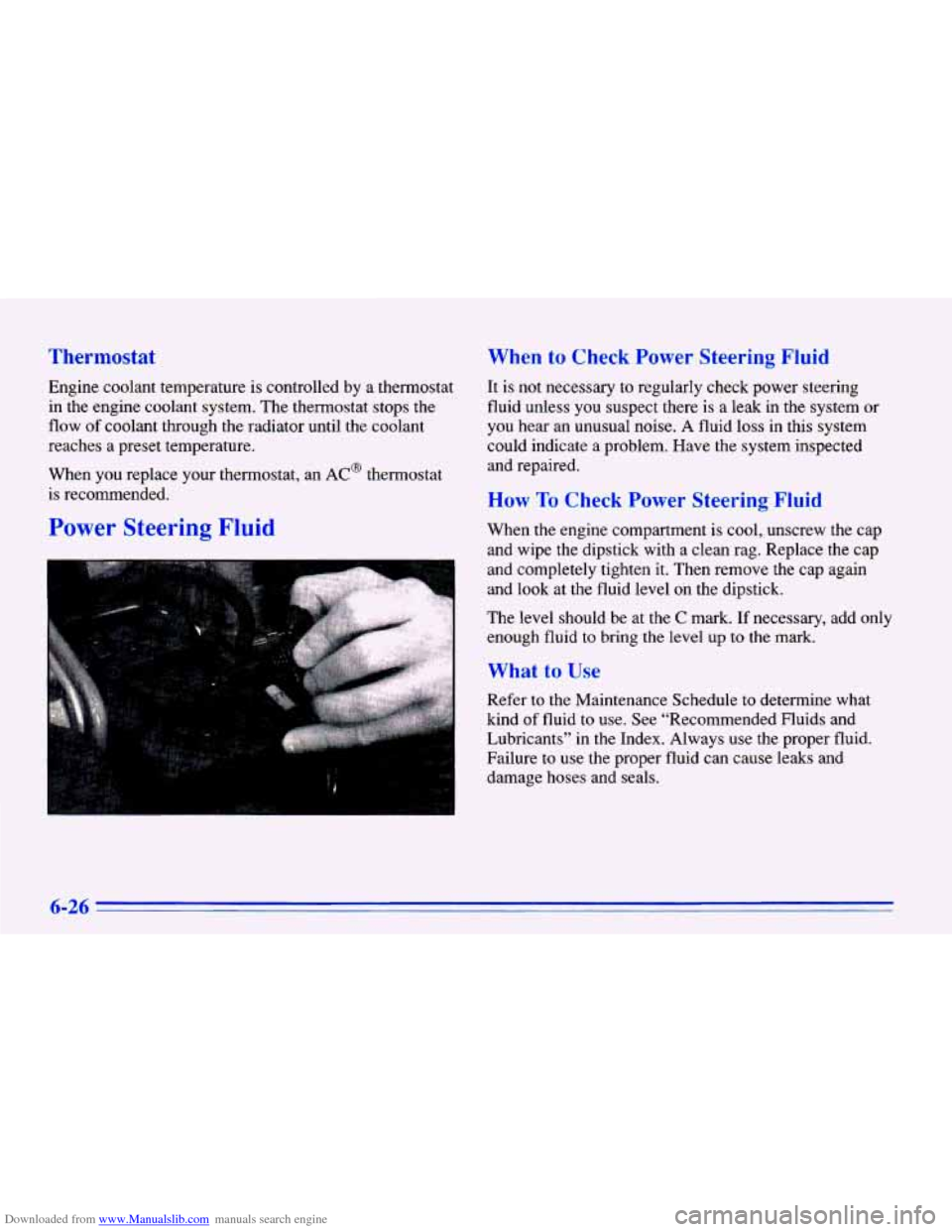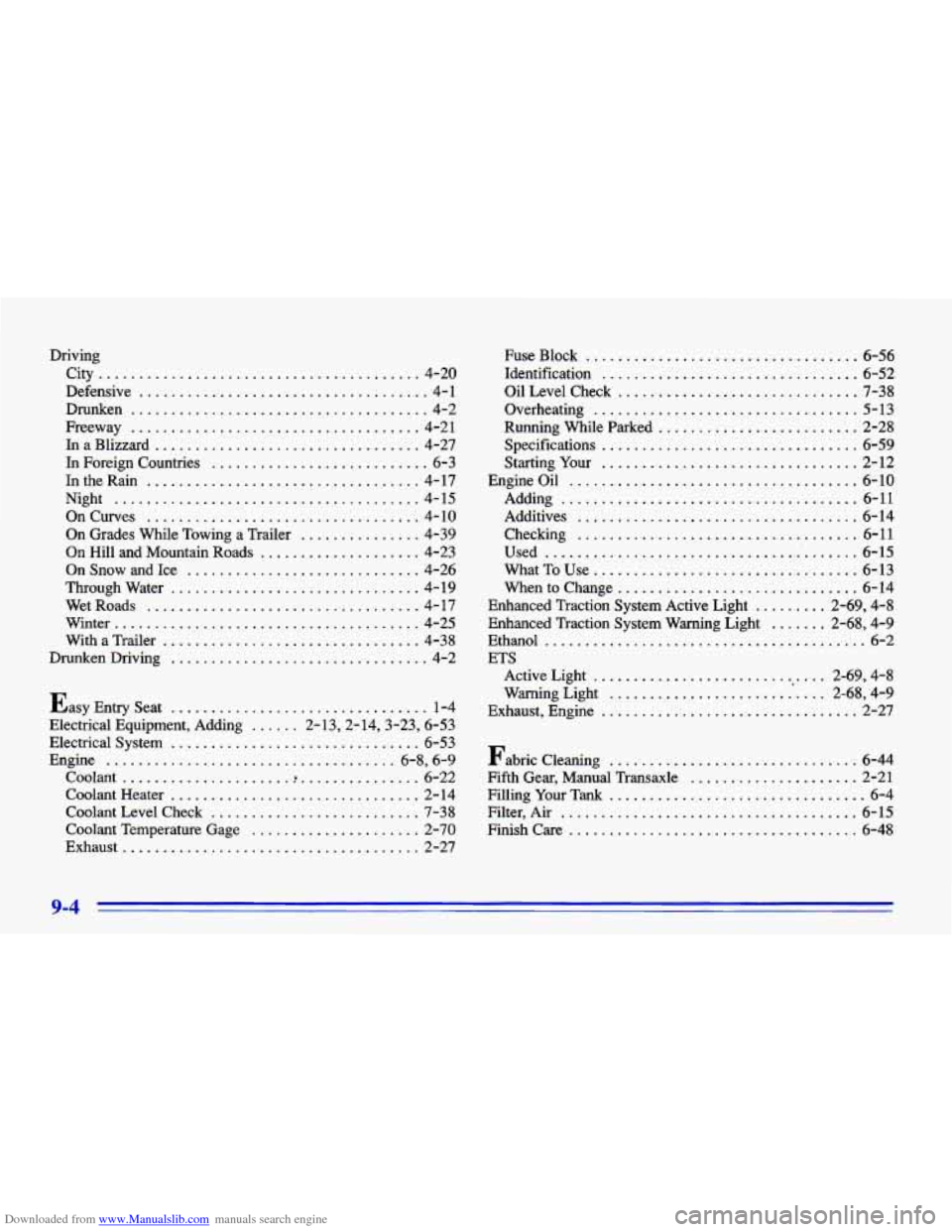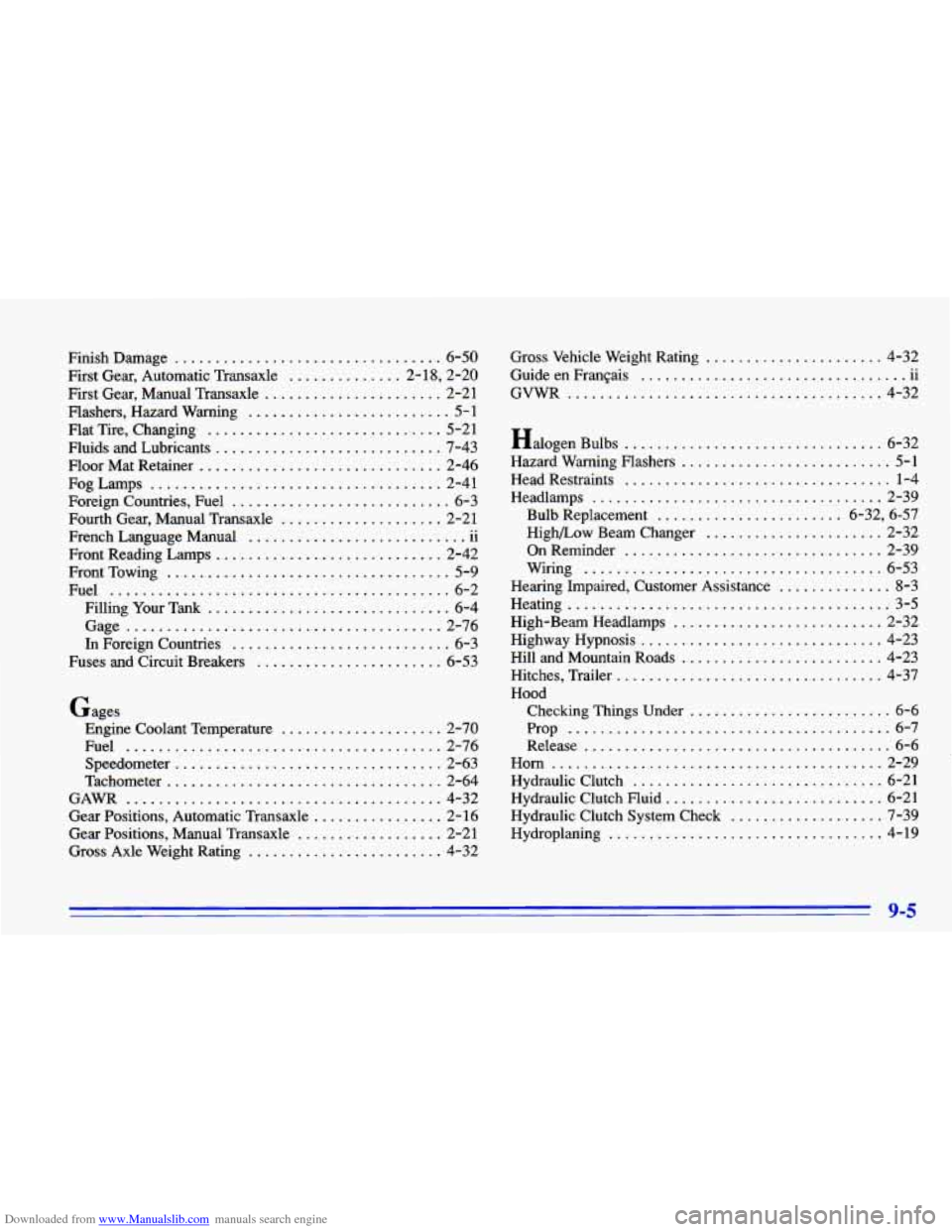coolant temperature CHEVROLET CAVALIER 1996 3.G Owners Manual
[x] Cancel search | Manufacturer: CHEVROLET, Model Year: 1996, Model line: CAVALIER, Model: CHEVROLET CAVALIER 1996 3.GPages: 372, PDF Size: 19.73 MB
Page 73 of 372

Downloaded from www.Manualslib.com manuals search engine Plugging the cord into an ungrounded outlet
could cause an electrical shock. Also, the wrong
kind
of extension cord could overheat and cause
a fire. You could be seriously injured. Plug the
cord into
a properly grounded three-prong
110-volt AC outlet.
If the cord won’t reach, use a
heavy-duty three-prong extension cord rated for
at least 15 amps.
2.4L Engine
In very cold weather,
0°F (- 18 O C) or colder, the engine
coolant heater can help. You’ll get easier starting and
better fuel economy during engine warm-up.
Usually,
the coolant heater should be plugged in a minimum of
four hours prior to starting your vehicle.
To use the coolant heater:
1. Turn off the engine.
2. Open the hood and unwrap the electrical cord.
3. Plug it into a normal, grounded 110-volt AC outlet.
4. After you’ve used the coolant heater, be sure to store
the cord as it was before to keep it away from moving
engine parts. If you don’t, it could be damaged.
How long should
you keep the coolant heater plugged
in? The answer depends on the outside temperature, the
kind of oil you have, and some other things. Instead
of
trying to list everything here, we ask that you contact
your Chevrolet dealer in the area where you’ll be
parking your vehicle. The dealer can give you the best
advice for that particular area.
2-15
Page 128 of 372

Downloaded from www.Manualslib.com manuals search engine Engine Coolant Temperature Gage
100
9
H
TEMP
Low Coolant Warning Light
1,1
If this light comes on and
stays on, your system is low
on coolant and the engine
may overheat.
Your vehicle
is equipped with one of these gages. With
the ignition in the
RUN position, this gage shows the
engine coolant temperature.
If the gage pointer moves into the red area, your engine
is too hot! It means that your engine coolant has
overheated.
If you have been operating your vehicle
under normal driving conditions,
you should pull off the
road, stop your vehicle and turn
off the engine as soon
as possible.
In “Problems on the Road,” this manual shows what
to
do. See “Engine Overheating” in the Index. See
the Index under “Engine Coolant” and have your
vehicle serviced
as soon as you can.
2-70
Page 141 of 372

Downloaded from www.Manualslib.com manuals search engine Heating
On cold days, use FLOOR with the temperature knob all
the way in the red area. The system will bring in outside
air, heat it and send it to the floor ducts.
Your vehicle has heat ducts that are directed toward
the rear seat. Keep the area under the front seats clear
of obstructions so the heated air can reach the rear
seat passengers.
If your vehicle has an engine coolant heater, you can use
it
to help your system provide warm air faster when it’s
cold outside
(0°F (-18°C) or lower). An engine coolant
heater warms the coolant your engine and heating
system
use to provide heat. See “Engine Coolant
Heater’’ in the Index.
Ventilation System
For mild outside temperatures when little heating or
cooling
is needed, use VENT to direct outside air through
your vehicle. Your vehicle
also has the flow-through
ventilation system described later in this section.
Your vehicle’s flow-through ventilation system supplies
outside air into
the vehicle when it is moving. Outside
air will also enter the vehicle when the air conditioning
fan
is running.
3-5
Page 217 of 372

Downloaded from www.Manualslib.com manuals search engine Engine Overheating
You will find a coolant temperature gage and a
low coolant warning light on your Chevrolet’s
instrument panel. Steam
from an overheated engine can burn you
badly, even if you just open the hood. Stay away
from the engine if you
see or hear steam coming
from it. Just turn it
off and get everyone away
from the vehicle until it cools down. Wait until
there is no sign of steam or coolant before
opening the hood.
If you keep driving when your engine
is
overheated, the liquids in it can catch fire. You or
others could be badly burned. Stop your engine
if
it overheats, and get out of the vehicle until the
engine is cool.
I NOTICE:
If your engine catches fire because you keep
driving with no coolant, your vehicle can be
badly damaged. The costly repairs would not be
covered by your warranty.
5-13
Page 260 of 372

Downloaded from www.Manualslib.com manuals search engine When to Check and What to Use
Refer to the Maintenance Schedule to determine how
often you should check the fluid level in your clutch
master cylinder reservoir and for the proper fluid. See
“Owner Checks and Services” and “Recommended
Fluids and Lubricants” in the Index.
How to Check
You do not need to check the fluid level unless you
suspect a clutch problem. To check the fluid level, take
the cap off.
If the fluid reaches the step inside the
reservoir, the fluid level
is correct.
Engine Coolant
The cooling system in your vehicle is filled with new
DEX-COOL TM (orange-colored, silicate-free) engine
coolant. This coolant is designed to remain in your
vehicle for
5 years or 100,000 miles ( 166 000 km),
whichever occurs first.
The following explains your cooling system and how to
add coolant when it is low. If you have a problem with
engine overheating, see “Engine Overheating” in
the Index.
A 50/50 mixture of water and the proper coolant for
your Chevrolet will:
Give freezing protection down to -34°F (-37OC).
e Give boiling protection up to 265 “F (129°C).
0 Protect against rust and corrosion.
e Help keep the proper engine temperature.
e Let the warning lights and gages work as
they should.
6-22
Page 264 of 372

Downloaded from www.Manualslib.com manuals search engine Thermostat
Engine coolant temperature is controlled by a thermostat
in the engine coolant system. The thermostat stops the
flow of coolant through the radiator until the coolant
reaches
a preset temperature.
When you replace your thermostat, an
AC’ thermostat
is recommended.
Power Steering Fluid
When to Check Power Steering Fluid
It is not necessary to regularly check power steering
fluid unless you suspect there
is a leak in the system or
you hear an unusual noise.
A fluid loss in this system
could indicate a problem. Have the system inspected
and repaired.
How To Check Power Steering Fluid
When the engine compartment is cool, unscrew the cap
and wipe the dipstick with a clean rag. Replace the cap
and completely tighten it. Then remove the cap again
and look at the fluid level on the dipstick.
The level should be at the
C mark. If necessary, add only
enough fluid
to bring the level up to the mark.
What to Use
Refer to the Maintenance Schedule to determine what
kind
of fluid to use. See “Recommended Fluids and
Lubricants” in the Index. Always use the proper fluid.
Failure
to use the proper fluid can cause leaks and
damage hoses and seals.
6-26
Page 362 of 372

Downloaded from www.Manualslib.com manuals search engine Driving City
........................................ 4-20
Defensive
.................................... 4- 1
Drunken
..................................... 4-2
Freeway
.................................... 4-21
InaBlizzard
................................. 4-27
In Foreign Countries
........................... 6-3
In the Rain .................................. 4-17
Night
...................................... 4-15
OnCurves
.................................. 4-10
On Grades While Towing a Trailer
............... 4-39
On Hill and Mountain Roads
.................... 4-23
On Snow and Ice
............................. 4-26
Throughwater
............................... 4-19
WetRoads
.................................. 4-17
Winter
...................................... 4-25
With a Trailer
................................ 4-38
DrunkenDriving
................................ 4-2
Easy Entry Seat
................................ 1-4
Electrical Equipment. Adding
...... 2.13.2.14.3.23. 6.53
Electrical System
............................... 6-53
Engine
.................................... 6.8. 6.9
Coolant
..................... ! ............... 6-22
Coolant Heater
............................... 2-14
Coolant Level Check
.......................... 7-38
Coolant Temperature Gage ..................... 2-70
Exhaust
..................................... 2-27 Fuse Block
.................................. 6-56
Identification ................................ 6-52
OilLevelCheck
.............................. 7-38
Overheating ................................. 5-13
Running While Parked
......................... 2-28
Specifications
................................ 6-59
Starting Your
................................ 2-12
Engineoil
.................................... 6-10
Adding
..................................... 6-11
Additives ................................... 6-14
Checking
................................... 6-11
Used
............................... .. ....... 6-15
What To Use
................................. 6-13
Whentochange
.............................. 6-14
Enhanced Traction System Active Light
......... 2-69. 4-8
Enhanced Traction System Warning Light
....... 2-68. 4-9
Ethanol
........................................ 6-2
ETS Active Light
............................. 2.69, 4-8
Warning Light
........................... 2.68. 4-9
Exhaust. Engine
................................ 2-27
Fabric Cleaning
............................... 6-44
Fifth Gear. Manual Transaxle
..................... 2-21
FillingYourTank
................................ 6-4
Filter. Air
..................................... 6-15
Finish Care
.................................... 6-48
Page 363 of 372

Downloaded from www.Manualslib.com manuals search engine Finish Damage ................................. 6-50
First Gear. Automatic Transaxle
.............. 2.18. 2.20
First Gear. Manual Transaxle
...................... 2-21
Flashers. Hazard Warning
......................... 5-1
Flat Tire. Changing
............................. 5-21
Fluids and Lubricants
............................ 7-43
Floor Mat Retainer
.............................. 2-46
FogLamps
.................................... 2-41
Foreign Countries. Fuel
........................... 6-3
Fourth Gear. Manual Transaxle
.................... 2-21
FrenchLanguageManual
11
Front Reading Lamps ............................ 2-42
Fuel
.......................................... 6-2
Filling Your Tank
.............................. 6-4
Gage ....................................... 2-76
In Foreign Countries ........................... 6-3
Fuses and Circuit Breakers
....................... 6-53
.I ...........................
FrontTowing ................................... 5-9
Gages Engine Coolant Temperature
.................... 2-70
Fuel
....................................... 2-76
Speedometer
................................. 2-63
Tachometer
.................................. 2-64
GAWR ....................................... 4-32
Gear Positions, Automatic Transaxle
................ 2- 16
Gear Positions, Manual Transaxle
.................. 2-21
Gross Axle Weight Rating ........................ 4-32 Gross Vehicle Weight Rating
...................... 4-32
Guide en Frangais
11
GVWR ....................................... 4-32
.. .................................
Halogen Bulbs ................................ 6-32
Hazard Warning Flashers
.......................... 5-1
Head Restraints
................................. 1-4
Headlamps
.................................... 2-39
Bulb Replacement
....................... 6.32. 6.57
Highbow Beam Changer
...................... 2-32
On Reminder
................................ 2-39
Wiring
..................................... 6-53
Hearing Impaired. Customer Assistance
.............. 8-3
High-Beam Headlamps
.......................... 2-32
Highway Hypnosis
.............................. 4-23
Hill and Mountain Roads
......................... 4-23
Hitches. Trailer
................................. 4-37
Hood
Heating
........................................ 3-5
Checking Things Under
......................... 6-6
Prop
........................................ 6-7
Release
...................................... 6-6
Horn ......................................... 2-29
Hydraulic Clutch
............................... 6-21
Hydraulic Clutch Fluid
........................... 6-21
Hydraulic Clutch System Check
................... 7-39
Hydroplaning
.................................. 4-19
9-5